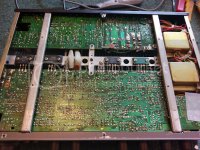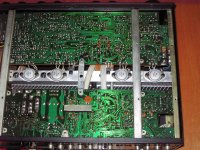Interesting amp this one,two seperate power supplies
Quite alot to go through with this one
The lamp is VERY bright if all fuses are in,but it is also on ,but dimmer if you take either sets of fuses out and leave the other in so there is obviously something wrong on both sides.
ive done some initial quick checks
all fuses in tact
rectifiers are giving out correct voltages, so at least for now it appears the transformers are ok
ill be doing some more in depth stuff at the weekend and ill report back as i go 🙂
Quite alot to go through with this one
The lamp is VERY bright if all fuses are in,but it is also on ,but dimmer if you take either sets of fuses out and leave the other in so there is obviously something wrong on both sides.
ive done some initial quick checks
all fuses in tact
rectifiers are giving out correct voltages, so at least for now it appears the transformers are ok
ill be doing some more in depth stuff at the weekend and ill report back as i go 🙂
Not so likely. Is the bulb in the tester sized reasonably for the power draw of the amp?
Last edited:
How are the DC voltages after the rectifiers correct, if the bulb is lit?
That should lower those voltages a lot.
That should lower those voltages a lot.
Should be an easy fix 😉
Think outside the box on how to get a handle on what is going. There are six fuses in 3 pairs. There are a couple of voltage checks that I would initially do when the lamp is bright...
Think outside the box on how to get a handle on what is going. There are six fuses in 3 pairs. There are a couple of voltage checks that I would initially do when the lamp is bright...
ive put it away for tonight but initialy i removed all fuses and replaced them one by one, and the lamp lit even with one fuse in
ive not realy got going with this yet
im not sure what voltages you would check first, i always check the ac voltages from the transfomer to the fuses then move on to the rectifier,then check the rail voltages ,but if there is something else you would do first im quite happy for you to advise 😀😉
i always check the simple bits first as i was always taught to check the fuse before you think of having to re wire the house 😀
ive not realy got going with this yet
im not sure what voltages you would check first, i always check the ac voltages from the transfomer to the fuses then move on to the rectifier,then check the rail voltages ,but if there is something else you would do first im quite happy for you to advise 😀😉
i always check the simple bits first as i was always taught to check the fuse before you think of having to re wire the house 😀
Last edited:
There's 2 transformers, 2 rectifiers, and 2 Power Supplies - but they're not really 'separate', each PS uses 2 secondaries, one from each transformer. It's a little like the 3020 PS, with the unregulated PS dedicated to the main amp output stages, but with more 'oomph' from the twin transformers.
Once you get into it - be sure to check all the service bulletins at the very end of the hifiengine service manual - they may save you a lot of time & head scratching. Depends which version & which mods you have.
Once you get into it - be sure to check all the service bulletins at the very end of the hifiengine service manual - they may save you a lot of time & head scratching. Depends which version & which mods you have.
Basically two mono amps in the same housing with possibly the pre amp from one supply?
Easier to analyze, just do one channel at a time.
Easier to analyze, just do one channel at a time.
im not sure what voltages you would check first, i always check the ac voltages from the transfomer to the fuses then move on to the rectifier,then check the rail voltages ,but if there is something else you would do first im quite happy for you to advise 😀😉
I would first check what voltage was across the 0.22 ohm resistors in the output stage, just for curiosity and just to see if that was where current was flowing. All fuses fitted for that.
Depending on that result I would then pull the four fuses related to the power amps and then see if the low voltage low current supplies come up to something like the correct voltage.
Yes. If current is flowing there it will show.
Just a thought as you said any fuse in place lights the bulb... have the output transistors been replaced incorrectly with no insulating pads or something like that?
Just a thought as you said any fuse in place lights the bulb... have the output transistors been replaced incorrectly with no insulating pads or something like that?
Yes. If current is flowing there it will show.
Just a thought as you said any fuse in place lights the bulb... have the output transistors been replaced incorrectly with no insulating pads or something like that?
nice easy access but a bit precarious in places
Attachments
I've seen worse, it actually looks very accessible for service. Looks like mix and match on the outputs 😀
Those Sanken? outputs are not original. I have a 3140 on the bench at present and the original outputs were MJ15003/MJ15004- both TO-3 cases.
- Home
- Amplifiers
- Solid State
- NAD 3140


